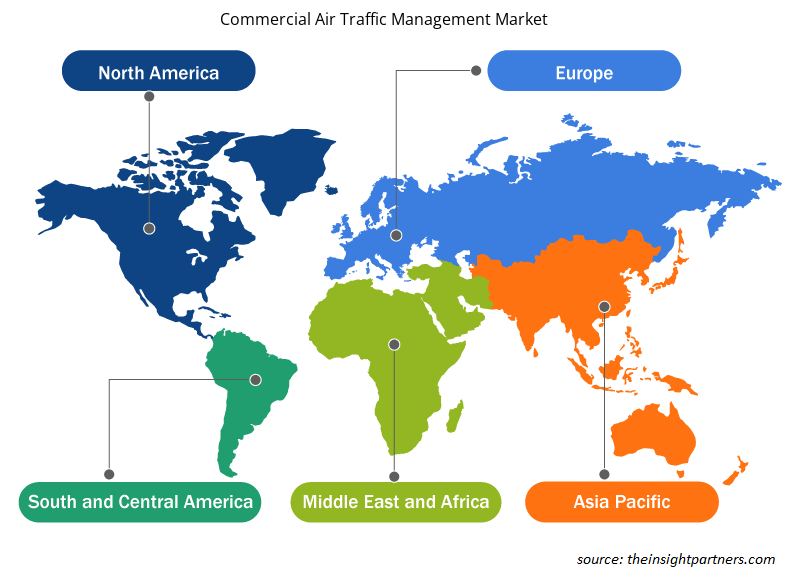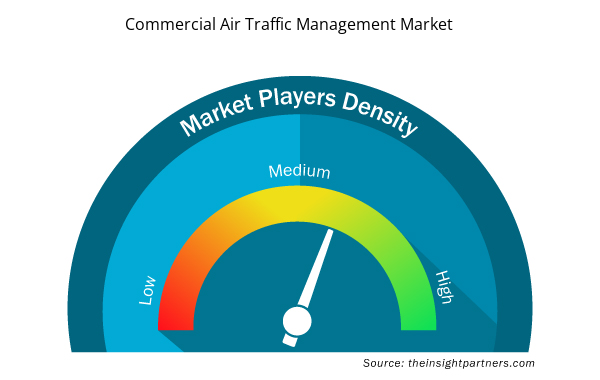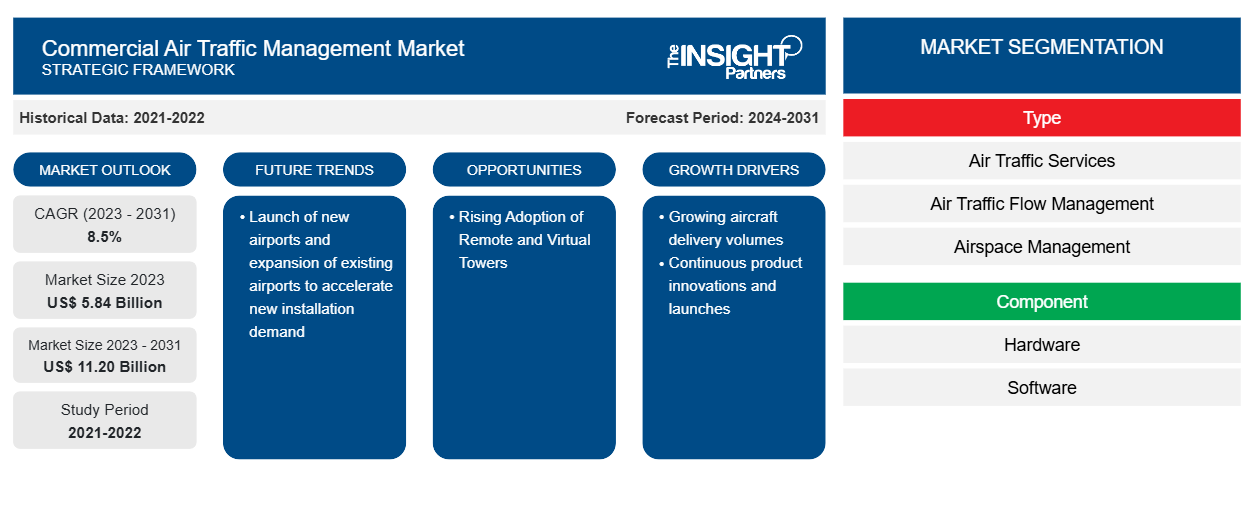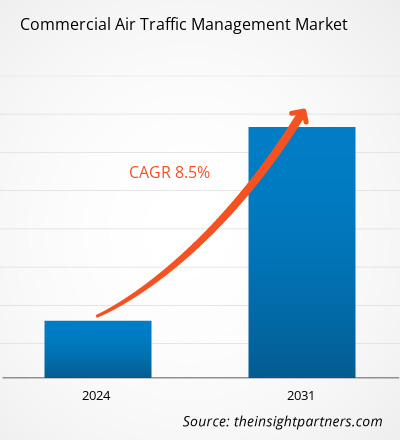商業航空交通管理市場の規模は、2023年の58億4,000万米ドルから2031年には112億米ドルに達すると予測されています。市場は2023年から2031年の間に8.5%のCAGRを記録すると予想されています。新規空港の開設と既存空港の拡張による新規設置需要の加速は、市場の主要なトレンドであり続けると思われます。
商業航空交通管理市場分析
商業航空交通管理市場の買い手には、効率的で安全な航空会社の運営のために高度な航空交通管理 (ATM) ソリューションの調達にますます投資している商業空港とその当局が含まれます。現在、空港建設プロジェクトが進行中であるため、買い手の購買力は中程度です。しかし、空港建設の終わりに近づくにつれて、ATM ソリューションの需要が増加し、買い手の交渉力が高まります。さらに、商業 ATM システムの耐用年数は長いため、現在は買い手の交渉力が低くなっています。しかし、空港全体で新しい ATM システムが更新される時期には、特に既存のシステムが今後数年間で買い手の交渉力を高めることが期待されます。
商業航空交通管理市場の概要
世界の商業航空交通管理市場のエコシステムにおける主要な利害関係者には、部品メーカー、ハードウェアメーカー、ソフトウェアプロバイダー、政府機関、エンドユーザーが含まれます。世界の商業航空交通管理市場で活動する部品メーカーは、送信機、アンテナ、受信機、インジケーター、バッテリー、ライト、センサー、その他の機器を提供しています。これらすべての部品をタイムリーに供給することは、航空交通管理システム製造工場全体の効率的な運用に不可欠です。これらの部品プロバイダーに運用上の影響があると、航空交通管理システムの生産に遅れが生じ、商業航空交通管理市場に直接影響を及ぼします。
要件に合わせてレポートをカスタマイズする
このレポートの一部、国レベルの分析、Excelデータパックなど、あらゆるレポートを無料でカスタマイズできます。また、スタートアップや大学向けのお得なオファーや割引もご利用いただけます。
- このレポートの主要な市場動向を入手してください。この無料サンプルには、市場動向から見積もりや予測に至るまでのデータ分析が含まれます。
商業航空交通管理市場の推進要因と機会
継続的な製品革新と発売
世界の航空業界は、新しい革新的な製品という点で変革を遂げています。業界全体の関係者は、産業運営を簡素化する堅牢なソリューションを革新し開発するために、継続的に研究開発に投資しています。航空交通管理システムの需要の高まりにより、市場関係者は近年、新しい革新的な製品の開発に投資せざるを得なくなりました。主な製品開発のいくつかを以下に示します。
- 2022 年 7 月、EUROCONTROL は更新された航空交通管理監視トラッカーおよびサーバー (ARTAS) をリリースしました。新しいバージョン (V 9.0.2) には、コミュニティから提供されたいくつかの新しい機能があり、そこで問題が解決されたと報告されています。
- 2022年6月、インドラ・システマスSAとユーロコントロール・マーストリヒト高所管制センター(MUAC)は、航空交通管制システムが航空交通を正確に管理できるようにする航空通信ネットワーク(ATN)と自動従属監視契約システム(ADS-C)の導入を発表しました。
- 2022年6月、タレスSAは、X線ナノテクノロジーベースの電子スキャンと3D画像再構成を組み合わせたC3準拠のスキャナーであるHELIXVIEWの発売を発表し、空港のセキュリティを強化し、乗客にシームレスな旅行施設を提供します。
このような発展により、商業航空交通管理市場は世界的に成長を続けています。
リモートタワーと仮想タワーの採用増加
リモートタワーと仮想タワーは、航空交通業務を遠隔から規制および維持するのに役立ちます。世界中のさまざまな空港が、より迅速で安全な空港運営のためにこれらのタワーを採用しています。2022年6月、ブリンディジ空港はイタリアで初の遠隔管理管制塔を開設しました。新しいリモートデジタルタワーは、航空管制官がリモートタワーモジュールから離着陸および地上業務を管理するのに役立ちます。このモジュールは航空交通管理にも役立ち、空港の安全性と運用効率を高めます。2022年5月、ドイツ北部のブラウンシュヴァイク=ヴォルフスブルク空港とエムデン空港が、DFS Aviation Services GmbH(DAS)とFrequentisに、この地域のリモートタワーセンターの建設を委託したことが発表されました。このセンターは、2024年半ばまでに運用を開始する予定です。したがって、効率的な航空交通管理のためのリモートタワーと仮想タワーの採用と投資の増加は、商業航空交通管理市場の成長を後押しすると予想されます。
商業航空交通管理市場レポートのセグメンテーション分析
商業航空交通管理市場分析の導出に貢献した主要なセグメントは、タイプ、コンポーネント、アプリケーション、および空港クラスです。
- タイプに基づいて、商業航空交通管理市場は、航空交通サービス、航空交通流管理、および空域管理に分類されます。空域管理セグメントは、2023年に大きな市場シェアを占めました。
- コンポーネントに基づいて、商用航空交通管理市場はハードウェアとソフトウェアに分かれています。ハードウェアセグメントは2023年に大きな市場シェアを占めました。ハードウェアセグメントはさらに、レーダー、アンテナ、ディスプレイシステムなどに細分化されています。
- アプリケーションに基づいて、商業航空交通管理市場は、通信、ナビゲーション、監視、交通管制、その他に分類されます。監視セグメントは2023年に大きな市場シェアを占めました。ナビゲーションセグメントは、CVOR、DVOR、DME、ILS、DF、NDBにさらに細分化されています。監視セグメントは、PSR、SSR、MLATにさらに細分化されています。
- 空港クラスに基づいて、商業航空交通管理市場はクラスI、クラスII、クラスIII、クラスIVに分類されます。クラスIセグメントは2023年に大きな市場シェアを占めました。
商業航空交通管理市場シェアの地域別分析
商業航空交通管理市場レポートの地理的範囲は、主に北米、ヨーロッパ、アジア太平洋、中東およびアフリカ、南米の 5 つの地域に分かれています。
2023年には北米が市場を支配し、ヨーロッパとアジア太平洋地域がそれに続きます。さらに、アジア太平洋地域は、今後数年間で最高のCAGRとともに北米市場を上回る可能性があります。米国は2023年に北米の商業航空交通管理市場を支配しました。これは主に、米国の航空業界が世界の航空部門の主要国の1つであるためです。この国は、年間数百万人の乗客に対応する航空機の艦隊の最大数を誇っています。たとえば、米国の航空会社は2023年に8億6,200万人以上の乗客を利用します。乗客数の増加により、米国の航空会社全体でより多くの航空機艦隊を調達し、ATM運用の要件が高まっています。さらに、米国のさまざまな空港にある既存のATCタワーのアップグレードと、米国のさまざまな空港にある新しいATCタワーの運用開始は、全国の商業航空交通管理市場の成長を促進しています。全国のいくつかの空港は、新しいターミナル、ATCタワーの建設、空港全体の他のセクターのアップグレードも含むさまざまな拡張プロセスを経ています。たとえば、2022年8月、フェニックスメサゲートウェイ空港は、アリゾナ州の空港全体で増加する航空交通を処理するためにATCタワーを商用化しました。同様に、連邦航空局(FAA)は、米国の空域の変革のために航空交通管理システムをアップグレードし、安全性、効率性、環境責任を強化するためのいくつかの空港計画を実施しています。このような要因は、北米地域における米国の商用航空交通管理市場の成長を推進してきました。
商業航空交通管理市場の地域別洞察
予測期間を通じて商業航空交通管理市場に影響を与える地域的な傾向と要因は、Insight Partners のアナリストによって徹底的に説明されています。このセクションでは、北米、ヨーロッパ、アジア太平洋、中東、アフリカ、南米、中米にわたる商業航空交通管理市場のセグメントと地理についても説明します。

- 商業航空交通管理市場の地域別データを入手
商業航空交通管理市場レポートの範囲
| レポート属性 | 詳細 |
|---|---|
| 2023年の市場規模 | 58億4千万米ドル |
| 2031年までの市場規模 | 112億米ドル |
| 世界のCAGR(2023年~2031年) | 8.5% |
| 履歴データ | 2021-2022 |
| 予測期間 | 2024-2031 |
| 対象セグメント | タイプ別
|
| 対象地域と国 | 北米
|
| 市場リーダーと主要企業プロフィール |
|
市場プレーヤーの密度:ビジネスダイナミクスへの影響を理解する
商業航空交通管理市場は、消費者の嗜好の変化、技術の進歩、製品の利点に対する認識の高まりなどの要因により、エンドユーザーの需要が高まり、急速に成長しています。需要が高まるにつれて、企業は提供内容を拡大し、消費者のニーズを満たすために革新し、新たなトレンドを活用し、市場の成長をさらに促進しています。
市場プレーヤー密度とは、特定の市場または業界内で活動している企業または会社の分布を指します。これは、特定の市場スペースに、その規模または総市場価値と比較して、どれだけの競合相手 (市場プレーヤー) が存在するかを示します。
商業航空交通管理市場で事業を展開している主要企業は次のとおりです。
- タレスSA
- BAEシステムズ
- インドラ・システマスSA
- L3ハリステクノロジーズ
- レイセオンテクノロジーズ
- ハネウェルインターナショナル
免責事項:上記の企業は、特定の順序でランク付けされていません。

- 商業航空交通管理市場のトップキープレーヤーの概要を入手
商業航空交通管理市場のニュースと最近の動向
商業航空交通管理市場は、主要な企業出版物、協会データ、データベースなどの一次調査と二次調査を経て定性的および定量的データを収集することで評価されます。商業航空交通管理市場の動向のいくつかを以下に示します。
- タレスは、2014年にザンビア空港公社(ZACL)と締結した契約に基づき、ザンビアのルサカ国際空港とリビングストン国際空港のATC(航空管制)センターを近代化しています。(出典:タレス、プレスリリース、2023年10月)
- EUROCONTROL MUAC と Indra は、飛行中の航空機とのデータ交換を自動化し、交通管理の精度を高める革新的な ATN 自動従属監視契約システム (ADS-C) を実装しました。これにより予測可能性が向上し、衝突の早期検出が容易になり、軌道ベース運用 (TBO) への第一歩となります。また、航空機の上昇と下降を最適化し、最適な飛行レベルをより長く維持し、燃料消費を最小限に抑えます (出典: Indra、プレスリリース、2022 年 6 月)
商業航空交通管理市場レポートの対象範囲と成果物
「商業航空交通管理市場の規模と予測(2021〜2031年)」レポートでは、以下の分野をカバーする市場の詳細な分析を提供しています。
- 対象範囲に含まれるすべての主要市場セグメントについて、世界、地域、国レベルでの商業航空交通管理市場の規模と予測
- 商業航空交通管理市場の動向、および推進要因、制約、主要な機会などの市場動向
- ポーターの5つの力の詳細な分析
- 主要な市場動向、世界および地域の枠組み、主要プレーヤー、規制、最近の市場動向を網羅した商業航空交通管理市場分析
- 市場集中、ヒートマップ分析、主要プレーヤー、商業航空交通管理市場の最近の動向を網羅した業界展望と競争分析
- 詳細な企業プロフィール
- 過去2年間の分析、基準年、CAGRによる予測(7年間)
- PEST分析とSWOT分析
- 市場規模価値/数量 - 世界、地域、国
- 業界と競争環境
- Excel データセット


- Smart Parking Market
- Europe Tortilla Market
- Vision Care Market
- Artificial Turf Market
- Non-Emergency Medical Transportation Market
- Adaptive Traffic Control System Market
- Nuclear Waste Management System Market
- Industrial Inkjet Printers Market
- Latent TB Detection Market
- Airline Ancillary Services Market

Report Coverage
Revenue forecast, Company Analysis, Industry landscape, Growth factors, and Trends

Segment Covered
This text is related
to segments covered.

Regional Scope
North America, Europe, Asia Pacific, Middle East & Africa, South & Central America

Country Scope
This text is related
to country scope.
よくある質問
North America region dominated the commercial air traffic management market in 2023.
Growing aircraft delivery volumes and continuous product innovations and launches are some of the factors driving the growth for commercial air traffic management market.
Launch of new airports and expansion of existing airports to accelerate new installation demand is one of the major trends of the market.
Thales SA, BAE Systems Plc, Indra Sistemas SA, L3Harris Technologies Inc, Raytheon Technologies Corporation, Honeywell International Inc, SAAB AB, SITA SC, NEC Corp, Nita LLC, JSC VNIIRA, Azimut JSC, and Leonardo SpA are some of the key players profiled under the report.
The estimated value of the commercial air traffic management market by 2031 would be around US$ 11.20 billion.
The commercial air traffic management market is likely to register of 8.5% during 2023-2031.
Trends and growth analysis reports related to Aerospace and Defense : READ MORE..
The Insight Partners performs research in 4 major stages: Data Collection & Secondary Research, Primary Research, Data Analysis and Data Triangulation & Final Review.
- Data Collection and Secondary Research:
As a market research and consulting firm operating from a decade, we have published and advised several client across the globe. First step for any study will start with an assessment of currently available data and insights from existing reports. Further, historical and current market information is collected from Investor Presentations, Annual Reports, SEC Filings, etc., and other information related to company’s performance and market positioning are gathered from Paid Databases (Factiva, Hoovers, and Reuters) and various other publications available in public domain.
Several associations trade associates, technical forums, institutes, societies and organization are accessed to gain technical as well as market related insights through their publications such as research papers, blogs and press releases related to the studies are referred to get cues about the market. Further, white papers, journals, magazines, and other news articles published in last 3 years are scrutinized and analyzed to understand the current market trends.
- Primary Research:
The primarily interview analysis comprise of data obtained from industry participants interview and answers to survey questions gathered by in-house primary team.
For primary research, interviews are conducted with industry experts/CEOs/Marketing Managers/VPs/Subject Matter Experts from both demand and supply side to get a 360-degree view of the market. The primary team conducts several interviews based on the complexity of the markets to understand the various market trends and dynamics which makes research more credible and precise.
A typical research interview fulfils the following functions:
- Provides first-hand information on the market size, market trends, growth trends, competitive landscape, and outlook
- Validates and strengthens in-house secondary research findings
- Develops the analysis team’s expertise and market understanding
Primary research involves email interactions and telephone interviews for each market, category, segment, and sub-segment across geographies. The participants who typically take part in such a process include, but are not limited to:
- Industry participants: VPs, business development managers, market intelligence managers and national sales managers
- Outside experts: Valuation experts, research analysts and key opinion leaders specializing in the electronics and semiconductor industry.
Below is the breakup of our primary respondents by company, designation, and region:

Once we receive the confirmation from primary research sources or primary respondents, we finalize the base year market estimation and forecast the data as per the macroeconomic and microeconomic factors assessed during data collection.
- Data Analysis:
Once data is validated through both secondary as well as primary respondents, we finalize the market estimations by hypothesis formulation and factor analysis at regional and country level.
- Macro-Economic Factor Analysis:
We analyse macroeconomic indicators such the gross domestic product (GDP), increase in the demand for goods and services across industries, technological advancement, regional economic growth, governmental policies, the influence of COVID-19, PEST analysis, and other aspects. This analysis aids in setting benchmarks for various nations/regions and approximating market splits. Additionally, the general trend of the aforementioned components aid in determining the market's development possibilities.
- Country Level Data:
Various factors that are especially aligned to the country are taken into account to determine the market size for a certain area and country, including the presence of vendors, such as headquarters and offices, the country's GDP, demand patterns, and industry growth. To comprehend the market dynamics for the nation, a number of growth variables, inhibitors, application areas, and current market trends are researched. The aforementioned elements aid in determining the country's overall market's growth potential.
- Company Profile:
The “Table of Contents” is formulated by listing and analyzing more than 25 - 30 companies operating in the market ecosystem across geographies. However, we profile only 10 companies as a standard practice in our syndicate reports. These 10 companies comprise leading, emerging, and regional players. Nonetheless, our analysis is not restricted to the 10 listed companies, we also analyze other companies present in the market to develop a holistic view and understand the prevailing trends. The “Company Profiles” section in the report covers key facts, business description, products & services, financial information, SWOT analysis, and key developments. The financial information presented is extracted from the annual reports and official documents of the publicly listed companies. Upon collecting the information for the sections of respective companies, we verify them via various primary sources and then compile the data in respective company profiles. The company level information helps us in deriving the base number as well as in forecasting the market size.
- Developing Base Number:
Aggregation of sales statistics (2020-2022) and macro-economic factor, and other secondary and primary research insights are utilized to arrive at base number and related market shares for 2022. The data gaps are identified in this step and relevant market data is analyzed, collected from paid primary interviews or databases. On finalizing the base year market size, forecasts are developed on the basis of macro-economic, industry and market growth factors and company level analysis.
- Data Triangulation and Final Review:
The market findings and base year market size calculations are validated from supply as well as demand side. Demand side validations are based on macro-economic factor analysis and benchmarks for respective regions and countries. In case of supply side validations, revenues of major companies are estimated (in case not available) based on industry benchmark, approximate number of employees, product portfolio, and primary interviews revenues are gathered. Further revenue from target product/service segment is assessed to avoid overshooting of market statistics. In case of heavy deviations between supply and demand side values, all thes steps are repeated to achieve synchronization.
We follow an iterative model, wherein we share our research findings with Subject Matter Experts (SME’s) and Key Opinion Leaders (KOLs) until consensus view of the market is not formulated – this model negates any drastic deviation in the opinions of experts. Only validated and universally acceptable research findings are quoted in our reports.
We have important check points that we use to validate our research findings – which we call – data triangulation, where we validate the information, we generate from secondary sources with primary interviews and then we re-validate with our internal data bases and Subject matter experts. This comprehensive model enables us to deliver high quality, reliable data in shortest possible time.


 このレポートの無料サンプルを入手する
このレポートの無料サンプルを入手する